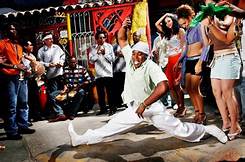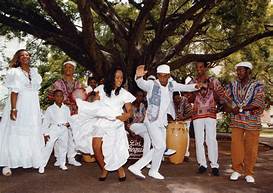JOSÉ ROSARIO “MALANGA” OVIEDO, EL MAS BRILLANTE BAILADOR DE RUMBA HASTA HOY CONOCIDOS. PHOTOS.
“Malanga” era un bailador muy respetado y querido en Unión de Reyes, siendo uno de los que introdujo la rumba en la parte central de la Isla. En La Habana dejó bien sentada su fama de bailador entre los rumberos de los barrios de Jesús María y Los Sitios.
Muchos coinciden en afirmar que “Malanga” fue el más brillante de los bailadores de rumba hasta ahora conocidos. Nadie lo llamaba por su nombre, José Rosario Oviedo, sino por el apodo de “Malanga”. Había nacido el 5 de octubre de 1885 en el Ingenio “La Esperanza”, del municipio de Alacranes, en La Habana.
Asiste a la escuela y aprende lo necesario, trabajo como mandadero y desde muy joven se le veían sus habilidades como bailarín, danzaba en todo tipo de fiestas populares y toques de santo. Así Malanga con su talento natural como rumbero se convirtió en un bailador muy respetado y admirado por todos.
HISTORIA DE LA RUMBA CUBANA…
En Cuba la Columbia, variante de la rumba, tuvo su génesis en los suburbios de los pueblos de Matanzas, sobre todo en los caseríos alrededor de los ingenios azucareros. No se puede precisar el lugar exacto donde nació, aunque es probable que haya sido en las llanuras de Colón, por lo que algunos musicólogos afirman que de ahí proviene su nombre. Cuando comienza la Columbia se canta algo parecido a un lamento, o “llorao” al estilo de los cantaores del flamenco andaluz.
VIDEO- La Historia de la Rumba, Yambú y Guaguanco…
La rumba Columbia se baila por hombres solos que danzan frente a los tambores demostrando su pericia. Esta variante de la rumba no es propia para que la bailen las mujeres, aunque ha pasado a la historia una famosa bailadora de Columbia llamada Andrea Baró, mencionada en algunas improvisaciones de rumba, en particular en canciones de Abelardo Barroso, como es el caso en “La Reina del Guaguancó”, de Alfredo Boloña, donde dice: “Los timberos están llorando la muerte de Andrea Baró…”
Según testimonios de los que tuvieron la suerte de ver bailar a Malanga, los pasillos y peripecias que realizaba eran sorprendentes. Creó un estilo que sobrepasó al repertorio de otros bailadores. Fue el primero que bailó con cuchillos afilados en las manos, realizando difíciles filigranas sin dejar de bailar. También se subía sobre una mesa con un vaso de agua en la cabeza haciendo todo tipo de evoluciones y no se derramaba ni una sola gota. Otra de sus ocurrencias era bailar con la punta de los pies, tal como lo hacen los bailarines de ballet.
Un amigo de Malanga conocido por “Chencho”, cuenta que en 1927 lo acompañó a una fiesta en Ceballos, actual provincia de Ciego de Avila, en cuyo lugar se daba una gran fiesta religiosa típica de las religiones yorubas para los santos y Malanga se destacó en una competencia de rumba con los bailadores reconocidos de la zona y éstos al verse aventajados por el matancero le lanzaron un maleficio.
LA MUERTE DE “MALANGA”…
Se cuenta que en la fiesta le sirvieron a comer arroz con quimbombó y carne de puerco y según se asume, en esa comida se ocultó el vidrio molido con que mataron a Malanga pues este se fue de la fiesta doblándose de los dolores en el vientre.
El final es un misterio, los resultados de la búsqueda de su acta de defunción en los registros civiles de la región no han ofrecido información. En esos tiempos la violencia, los homicidios, las agresiones físicas y la criminalidad social eran alarmantes ya que las estadísticas muestran una de las mayores tasas de homicidios de la historia.
VIDEO- Historia de “Malanga” y la rumba…
El final es un misterio, los resultados de la búsqueda de su acta de defunción en los registros civiles de la región no han ofrecido información.
Su desaparición física fue recogida en una rumba de la variante Columbia que se ha convertido en un verdadero clásico del género. Es la que dice así:
Siento una voz que me dice,
Siento una voz que me dice:
Malanga murió.
Unión de Reyes llora,
porque Malanga murió
Unión de Reyes llora
a su timbero mayor
Que vino regando flores,
desde Matanzas a Morón.
La popular rumba la compuso uno de los tamboreros de Malanga llamado José Drake y otro bailador de Cárdenas de nombre Félix Chapé. Fue compuesta cuatro años después de la muerte de Malanga, durante un velorio simbólico y homenaje póstumo al más popular de todos los rumberos. Su muerte ocurrió en el apogeo de su gloria. Su extraña muerte, y la popularidad de la rumba creada en su memoria, hicieron que su fama como rumbero excepcional perdure hasta nuestros días.
La rumba en cuestión fue popularizada por Chano Pozo, Arsenio Rodríguez, Carlos Embale y Miguelito Valdés, entre otros.
JOSÉ ROSARIO “MALANGA” OVIEDO, IS THE MOST BRILLIANT RUMBA DANCER KNOWN UNTIL TODAY. PHOTOS
“Malanga” was a highly respected and beloved dancer in Unión de Reyes, being one of those who introduced the rumba in the central part of the island. In Havana, he left his fame as a dancer well established among the rumba dancers of the Jesús María neighborhoods. and The Sites.
Many agree that “Malanga” was the most brilliant of the rumba dancers known so far. Nobody called him by his name, José Rosario Oviedo, but by the nickname “Malanga”. He was born on October 5, 1885, in the “La Esperanza” Sugar Mill, in the municipality of Alacranes, in Havana.
He attends school and learns what is necessary, he works as an errand boy, and from a very young age his skills as a dancer were seen, he danced in all kinds of popular festivals and touches of saint. Thus, Malanga, with his natural talent as a rumbero, became a dancer highly respected and admired by all.
HISTORY OF THE CUBAN RUMBA…
In Cuba, the Columbia, a variant of the rumba, had its genesis in the suburbs of the towns of Matanzas, especially in the hamlets around the sugar mills. The exact place where he was born cannot be specified, although it is likely that it was in the plains of Colón, which is why some musicologists affirm that his name comes from there. When the Columbia begins, something similar to a lament is sung, or “llorao” in the style of Andalusian flamenco singers.
The Columbia rumba is danced by men alone who dance in front of the drums demonstrating their skill. This variant of the rumba is not suitable for women to dance, although a famous dancer from Columbia named Andrea Baró has gone down in history, mentioned in some rumba improvisations, particularly in songs by Abelardo Barroso, as is the case in “La Reina del Guaguancó”, by Alfredo Boloña, where he says: “The timberos are crying the death of Andrea Baró…”
According to testimonies of those who were lucky enough to see Malanga dance, the corridors and adventures that she performed were surprising. She created a style that surpassed the repertoire of other dancers. He was the first to dance with sharp knives in his hands, performing difficult filigrees without stopping dancing. She would also climb on a table with a glass of water on her head doing all kinds of evolutions and not a single drop would be spilled. Another of her occurrences was to dance on the balls of her feet, just like ballet dancers do.
A friend of Malanga known as “Chencho”, tells that in 1927 he accompanied him to a party in Ceballos, current province of Ciego de Avila, in which place a great religious festival typical of the Yoruba religions was given for the saints and Malanga stood out in a rumba competition with the well-known dancers of the area and these, seeing themselves outdone by the man from Matanzas, cast a curse on him.
THE DEATH OF “MALANGA”…
It is said that at the party they served him rice with okra and pork meat and it is assumed that the ground glass with which they killed Malanga was hidden at that meal because he left the party doubling over from pain in his belly.
The end is a mystery, the results of the search for his death certificate in the civil registries of the region have not offered information. In those times the violence, the homicides, the physical aggression, and the social criminality were alarming since the statistics show one of the highest homicide rates in history.
The end is a mystery, the results of the search for his death certificate in the civil registries of the region have not offered information.
His physical disappearance was recorded in a Columbia variant rumba that has become a true classic of the genre. It is the one that says:
I feel a voice that tells me,
I hear a voice that tells me:
Malanga died.
Union of Kings cries,
because Malanga died
Union of Kings cries
to his older timbero
That he came watering flowers,
from Matanzas to Morón.
The popular rumba was composed by one of the drummers from Malanga named José Drake and another dancer from Cárdenas named Félix Chapé. It was composed four years after Malanga’s death, during a symbolic wake and posthumous tribute to the most popular of all rumberos. His death occurred at the height of his glory. His strange death, and the popularity of the rumba created in his memory, made his fame as an exceptional rumbero to endure to this day.
The rumba in question was popularized by Chano Pozo, Arsenio Rodríguez, Carlos Embale and Miguelito Valdés, among others.
Agencies. Wiki. MemoriaCubanas. MalangaBio. Extractos. Excerpts. Internet Photos. YouTube. Arnoldo Varona. www.TheCubanHistory.com
THE CUBAN HISTORY, HOLLYWOOD.









